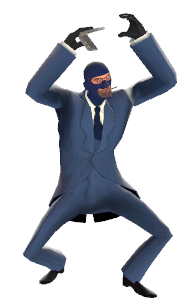Overview
Fan Service, as a broad definition, can refer to any sort of content that is unrelated to the game as a whole, but as a means to entertain the player, as well as a fanbase. Such examples include small and subtle nods, such as an easter egg or a recurring joke. However, sometimes, a whole game can be made based on this idea with the actual gameplay being overshadowed by the overall experience.
Types
Sexual
See also: Sexualized Women
The most widely-known types of fan service are the ones meant to titillate the player. Usually targeted towards males, these include scenarios where female characters' bodies are put on showcase through cleavage shots, bathing scenes, brief moments of nudity, unnatural breast jiggling, and/or skimpy clothing. Sometimes, players can collect photos of characters in erotic poses.

While using sex to sell a game is not unheard of in the West, sexual fan service is most common in Japanese media. "Fan Service" is actually a term used most often in anime and its fandom. Many Japanese animes, as well as games, have female characters with attractive, if not impossible, bodies. Sometimes this may be sole purpose of giving some extra sex appeal, and when this happens developers may put the characters in the aforementioned scenarios.
The most well-known example of this has been the fighting-game franchise Dead or Alive, and its recent volleyball and beach-sport spinoffs. The series, famous for its roster of beautiful well-endowed women, has used the perfect bodies of their female cast to their advantage by giving them revealing clothing and breast physics. The recent Beach Volleyball titles built on this premise by letting the players pose the characters and move the camera to focus on certain points of the character.
Self-Referential

See also: Self-referential Humor
These include references, or nods, to past entries in a certain franchise. These could come up by including short appearances by fan-favorite characters, in-jokes, parody, or small-but-respected aspects of a game. For example, in Metal Gear Solid 3: Snake Eater, numerous jabs are made at the character Raiden, including a character based off him, based on his effeminate personality. While he wasn't in this installment, the joke arose from the negative feedback of the character's surprise debut in Metal Gear Solid 2: Sons of Liberty.
Some games, developed by companies with close ties with their fanbases, would include content or nods to jokes made by their fanbase. Past class updates and promotional videos of Team Fortress 2 have made references to their fanbases' culture by including audio files, among other things, that joke about the Pyro's uncertain gender and the Scout's resemblance to ShamWow! pitchman Vince Offer. Additionally, for the Spy Update, Valve gave the class a taunt based on the "Spy Crab"; an animation glitch that players found humorous.
Company Referential / Nostalgia
Sometimes a company would put out a game that is chock-full of references to old titles, some obscure and some fan-favorites, implemented as a game's key feature or marketing tool. These can include the appearances of certain characters, songs, items, and locations from different franchise universes. The most noted example has been Nintendo's cross-over fighting series, Super Smash Brothers. While the original was a budget fighter using only large-profile Nintendo protagonists (as well as a couple lesser-known characters), its sequel took the opportunity to make the franchise into a showboat of nostalgia. Super Smash Brothers: Melee included a larger roster of lesser-known characters, as well as unlockable music and "trophies" (figurines) of Nintendo characters.

Sometimes, developers may include a bonus level or area, that was featured in an earlier game. One world in Super Mario Galaxy 2, called the " Throwback Galaxy", is an enhanced remake of Whomp's Fortress from Super Mario 64. Another example is the "Lost in Nightmares" DLC for Resident Evil 5, in which Chris Redfield and Jill Valentine traverse and solve puzzles in a mansion very similar to that of Resident Evil. Other callbacks included lines from the original, identical puzzles involving unlocking doors with crests, and camera angles and animations used in the first game.
In some other cases, though, a company could just include a reference a different game from one of their different franchises as an easter egg or in-joke. In Valve's Left 4 Dead 2 a jukebox that plays some of the game's key tracks in programmed to play, at rare occurrences, the song "Still Alive" from their popular puzzle game Portal.
Cameos / Crossovers
See also: Cameo Appearance, Crossover

As stated with the example of the Super Smash Brothers franchise, some games are used to set a scenario where two different franchises, or even companies, meet in a single universe. Sometimes, games may be made mix more than one completely unrelated characters together in a single universe. One recent example is Poker Night at the Inventory, which features Telltale characters as well as a few special guests playing poker. Character crack jokes about each other and making references to their respective franchise.
Crossover fighters are the most noteworthy of this practice since, most of the time, the characters are almost totally unrelated to each other. When such games are announced, there is much fan speculation on which ones will make it in. The recent installment in the Marvel vs. Capcom franchise is one good example because fans could be speculative of a slowly revealed roster and surprised/excited when the character is formally revealed. These games also have fighting moves, and other small details, may also be based on certain aspect of the character or game that are not only meant to keep with canon but also amuse the player. One that is noteworthy of being 'fan service', however, was the inclusion of Solid Snake and Sonic the Hedgehog in Super Smash Brothers: Brawl. The latter was demanded for years by fans who wanted to see a long-waited battle between him and Mario.
Log in to comment